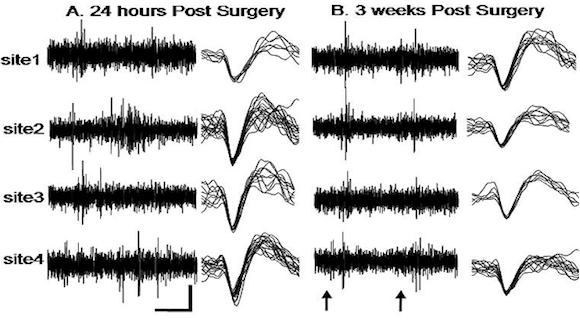Development of a novel intracortical electrode
Individuals that significantly damage their spine will eventually have loss of movement (partial or complete paralysis). Intriguingly, in such individuals, the brain region that corresponds to carrying out movement is still active, but the communication between this area, the spinal cord and the muscle has been severed resulting in the inability to carry out movement. Therefore it was proposed that recording and interpreting electrical information from the active brain region with the use of electrodes in such individuals could result in them being able to control a robotic limb.
Current electrode designs fail to give clear discriminable recordings after a month or so after insertion into the brain (see figure), which is problematic and clinically unacceptable when trying to formulate a long term neural prosthetic solution for paralysed patients. This electrode failure is primarily due to the activation of the brain’s immune system which essentially “attacks” the electrode as it is a “foreign invader,” coating the electrode with proteins and thus isolating it from the recording tissue.
This project looks at designing a novel chronic electrode for extracellular recordings. This may have eventual application in long term tracking of plasticity/learning and neural prosthetics.

People involved in this project
- Harbaljit Sohal (PhD student)
- Prof Stuart Baker (Supervisor)
- Dr Andrew Jackson (Supervisor)
- Prof Anthony O'Neill (Supervisor)
References
- Moxon KA, Leiser SC, Gerhardt GA, Barbee KA, Chapin JK. Ceramic-based multisite electrode arrays for chronic single-neuron recording. IEEE Trans Biomed Eng 2004;51:647-56.
Sponsors of this study
Back to the Projects



